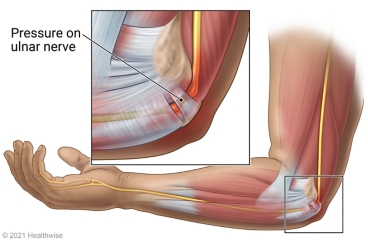Understanding Ulnar Nerve Surgery: A Guide to Surgery for Ulnar Nerve Compression
The ulnar nerve is one important nerve that passes through your arm and into your hand. It’s also called your funny bone nerve. This nerve helps you grip things with your hand and aids fine motor skills like writing. If pinched or compressed, this nerve can cause pain, stiffness, and weakness. They usually happen in sports and in people whose hands, wrists, and forearms do the same things repeatedly. This blog will explore the importance of ulnar nerve surgery in treating ulnar nerve compression.
What is Ulnar Nerve Compression?
Cubital tunnel syndrome, or ulnar nerve compression, happens when the nerve gets compressed at the elbow. This nerve also sends signals to the fourth and fifth fingers (ring and little fingers), part of the palm, and the bottom of the wrist.

When the ulnar nerve gets pinched, it can hurt, numb, or tingle in the elbow and fourth and fifth fingers. This condition can make the hand and fingers tingle, numb, and lose strength.
When is Surgery for Ulnar Nerve Compression Needed?
While mild cases of ulnar nerve compression can be treated with rest, bracing, and physical therapy, severe cases often require surgery. If symptoms persist despite non-surgical treatments, or if muscle weakness and nerve damage are worsening, a doctor may recommend ulnar nerve surgery to relieve pressure on the nerve and restore function.
Types of Surgeries:
Different types of surgery can be used to treat ulnar nerve compression depending on how bad the compression is and where it is.
1. Ulnar Nerve Decompression
The process takes out tissue that might put pressure on the ulnar nerve.
2. Ulnar Nerve Transposition
The ulnar nerve may be relocated to another arm site to prevent compression. The nerve may be moved under the skin, muscle, or elbow groove.
3. Medial Epicondylectomy
This treatment relieves ulnar nerve pressure by eliminating a tiny elbow bony protrusion. It is usually done when other surgeries fail.
What to Expect from Ulnar Nerve Surgery?
Before Surgery:
- Your doctor will review your symptoms and do nerve conduction studies or electromyography (EMG) to check nerve function.
- Your surgeon may advise you to quit certain drugs before surgery.
During Surgery:
- The procedure is usually done under local or general anaesthesia.
- It may take 30 minutes to an hour, depending on the surgery.
After Surgery:
- Patients may have moderate discomfort, oedema, and stiffness that progressively resolve.
- A splint or bandage can stabilise the arm during healing.
- Physical therapy and exercises are often recommended to regain strength and mobility.
- If the nerve damage was severe before surgery, healing can take weeks or months.
Benefits of Ulnar Nerve Surgery:-
- Relief from pain, numbness, and tingling.
- Hand and arm function improved.
- Preventing nerve and muscle injury.
- Greater mobility and comfort enhanced quality of life.
Conclusion
Ulnar nerve pinching can be very painful, and it usually gets worse if you keep your elbow bent for a long time, especially at night while you sleep. Medical attention is needed for persistent ulnar nerve compression symptoms. Ulnar nerve surgery is efficient at relieving nerve pressure and restoring function. An expert can help you choose the best treatment for your problem, providing long-term relief and healing.
If you would like to know more about the surgery for ulnar nerve compression, please call us at +44 7932 233168

The sentences flow with a contemplative rhythm, encouraging a mindful reading pace, where the reader can dwell on ideas, absorb layers of significance, and experience the text as both soothing and intellectually engaging.